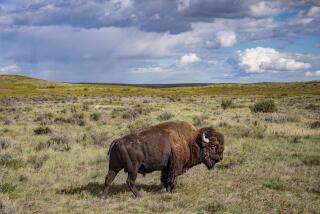A Friend of the Old Frontier : THE WANING OF THE WEST <i> by Stan Steiner edited with reflections by Emily Skretny Drabanski (St. Martin’s Press: $18.95; 300 pp.; 0-3123-03000-2) </i>
Stan Steiner died of a heart attack on Jan. 12, 1987, while working on the last section of this book, one of more than 20 he wrote. He was suffering from Parkinson’s disease and, true workman that he was, died at his typewriter, his last sentence being: “Who was this new man?” He came West, like most people in the region, after World War II, eventually settling permanently in Santa Fe about 1970, and devoted his life in good part to recording the pockets of traditional cultures being buried alive by the postwar boom. Often, his books recorded elements he saw as the bone and sinew that made the West more than a direction (“The Ranchers”: a book of generations). Mainly, they lived or died less from his analysis than from the voices he faithfully recorded, what Steiner liked to call testaments.
This last book, with a moving foreword by fellow New Mexican John Nichols, functions as an anthology of his life’s work. Some of the pieces are reprinted from early publications, many are new, and it’s a good place for a reader to dip into the world of Stan Steiner. He liked to work from note cards and then would fuse the cards together into chapters. And that is why his work feels less an argument than a series of rendered moments. The five parts hit his preoccupation with what the Old West meant, and his pioneering interest in both the role of women in settling the region (way underestimated in his mind) and the strain of the silent, hard Marlboro man stance on the menfolk. There is also a collection of pieces on the importance of minorities (including Steiner’s striking essay, “Jewish Conquistadors: America’s First Cowboys?”), and an effort to plumb some kind of meaning from that favorite Sun Belt piece of jargon, New West. The book ends with two long interviews with Steiner on his work habits and work goals.
The title comes from Steiner’s sense that “The West, I think, is dying. It is dying very quickly. The energy sources of America are here, and because of that we will be industrialized and we will be destroyed.” This is the traditional lament of inhabitants of the region, a place where everyone, including the Indians with their migration stories, and the Hispanics, who until this century constituted a small population, seems to have come from somewhere else. When pioneers in Arizona started a historical society in 1884 (because in the words of Bill Oury, a survivor of the Apache wars, “we have no frontier to which the pioneer may flee to avoid the tramp of civilized progress,”) the group had a savage debate over who was eligible to join, some opting for immigrants before 1880, some 1876, some 1870. Steiner elects to see the last flourish of the West in the years following 1945, a time when he arrived as a young hitchhiker and believed he found real Westerners still living on the land. But then the thesis, the waning of the West, is not that important to the thrust of this book or to Steiner’s life’s work. Steiner was less a writer of ideas than a recorder of people talking about how they had lived.
His great strength was his willingness to listen to people, often people other writers ignored. At the end of the book, he talks about just how he worked. He hated the idea of interviews and saw his dealings with people as conversations, talks that could take years. He did not so much ask questions as get his subjects rolling--a technique that should be drilled into the nation’s reporters. Thus, he did not seek simply answers, but rather the feel, the taste, the experience of the life. He was incredibly sensitive to his subjects’ desires. He states that he would not undertake a book unless the people involved--Indians, Hispanics, whoever--personally approved of the project. Once, a Chicana upon meeting him expressed surprise that he was not Hispanic. When he asked why, she explained, “Well, you know so much about us but you never write the bad things.” Even his piece on the militarization of the West (“When the Bomb Fell on New Mexico”) winds up more a consideration than a condemnation.
Where he sings is when he follows his instincts. For it was Steiner who brought us the early report of a new activism among American Indians, who very early noticed a new surge of pride and political ambition among Mexican-Americans, and who insisted, correctly, that we could not understand the history of the West without including the Chinese who suffered horrors building the first transcontinental railroad. And it was Steiner who brought us the words and feelings of the laconic ranchers who are hidden from view up 10 miles of bad road, but who live the land as a daily and lifelong experience. Without Steiner we’d never hear the pith of moments like the one where he asked a rancher what he thought about the “mythic West,” and the man snapped, “If someone else ever comes up to me again and calls me a myth, I’ll kick him in the ass.”
He was a student of his new home, this idea called the West, and because he was a diligent student who loved his subject, he often became our guide. He introduced us to people we’d probably never meet on our own, but should know if we’re going to take care of business. And that’s more than most writers ever even aim at.
From “The Waning of the West.”:
Evenings, the covered wagons often formed a circle so that man and wife might sleep alone--under a blanket on the ground. The circle of wagons was less for protection against curious Indians than for the protection of marital harmony and loving.
On the open and endless horizons of the West the pioneer men and women were probably more closely crowded together than they had been on their farms and in their towns back East. Each covered wagon had “to sleep a small family” for months, as J. M. Shively recalled of his trek across the Oregon Trail in 1846. For “the emmigrant caravans creeping on their slow procession” moved “inch by inch,” as historian Francis Parkman wrote in 1849 in The Oregon Trail, and the crowded conditions only could be survived by the muting of emotions and subduing of passions.
Romance on the wagon trail may have survived the journey but not likely the confines of these “schooners” of the prairie. The wagons were not only as plodding and clumsy as the oxen who pulled them, but also were unromantic and as foul-smelling as the cloven beasts. And men seldom rode in or drove the wagons; that was considered to be “women’s work.”
The sod huts and log cabins the pioneers built at the end of their journey were no better. In a prairie home “the sleeping arrangements (were) of a somewhat perplexing character,” was the laconic comment of William Fowler in Woman on the Frontier, in the late nineteenth century. Few had a private bed. And husband and wife often “had to repose on the floor, with buffalo robes for pillows and with their feet toward the fire,” while the children “played like kittens” in their communal bed. In the corner of the room stood the family cow, several dogs and perhaps a prize sow. Managing such a one-room household, the pioneer mother was soon as “thin as a shadow, pinched and wrinkled by hard labor,” wrote Fowler--and perhaps by lack of sleep.
“The plainness of the habitaton” of these pioneer men and women was more than a way of life; it became a moral code. . . . The austerity of daily life resulted in a philosophy in which poverty became a virtue and modesty became the measure of morality. “It is the iron band of poverty, of necessity, of austerity, which excluded them (the settlers) from sensual enjoyment,” wrote Ralph Waldo Emerson in Society and Solitude. It also made them, “despite themselves, reverers of the grand, the beautiful, the good”. . . .
For all that, these were robust and lusty men and women. The crossing of a continent and the settling of an unknown and frightening land could not have been done by timid souls.
--From “The Waning of the West.”
More to Read
Sign up for our Book Club newsletter
Get the latest news, events and more from the Los Angeles Times Book Club, and help us get L.A. reading and talking.
You may occasionally receive promotional content from the Los Angeles Times.









